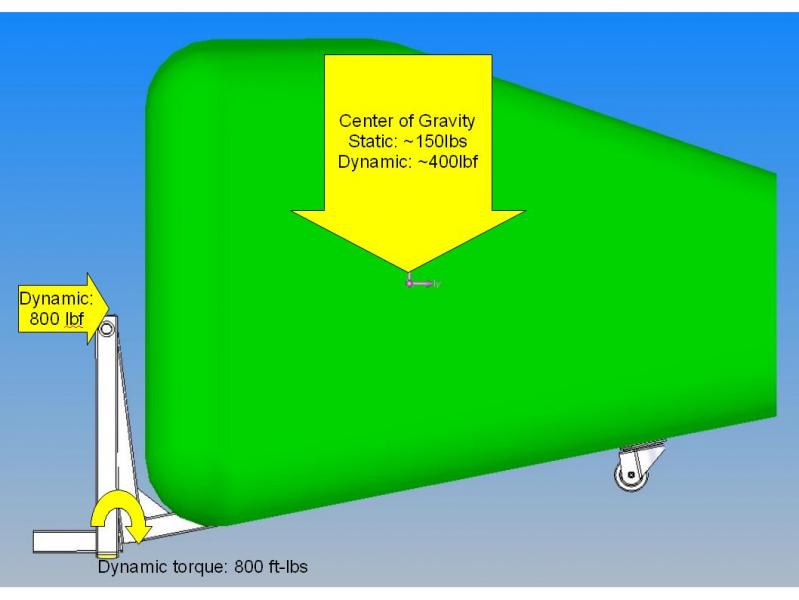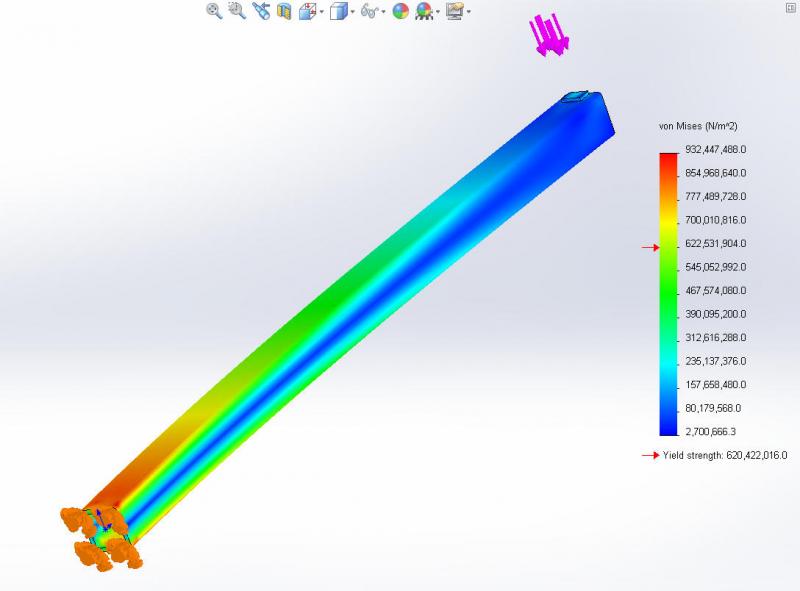Quick mind dump on some design issues that I over-analyzed:
Strength
In the interest of not loosing our stuff and ruining a family trip, I put some thought into the most prominent forces the frame has to withstand, i.e. the bumpy road scenario.
Self-explanatory.

I came at this from a couple directions, but I think 120-wall (1/8") 1.25" square tubing has a yield strength that can be expressed as a torque of about 2,000 ft-lbs. Here is a 2-ft length of the stuff in Solidworks Simulation (formerly COSMOS), 1,000 lbf load on the end of a cantilever:

Of course this number needs to be derated for a number of factors; fatigue, localized stress, and rust, but I think it's pretty reasonable to expect this material to handle 600 to 800 ft-lbs for a lifetime. So assuming the box itself is under 50 lbs, considering all the margins I've thrown in, we'll probably be pretty safe if we keep the load under 150 lbs as a rule.
120-wall also seemed like an intuitive selection, but I wanted to go through this exercise because the hitch-rack I'm replacing actually uses a solid 1.25" square instead of tubing. (
This one.) That seems pretty over-rated. I can't even bend the 120-wall with a sledge hammer (at least not with some wood buffers to prevent marring).
The carrier I'm replacing also weighs 49 lbs including the bag. I'd like to beat that number.
EDIT: I also put some thought into making the welds less critical - trying to have at least double the surface area of the tube in weld cross section.
Weight
The frame is about 19 lbs. There's at least 2.5 lbs I could have taken out of the side rails if I'd found just the right c-channel.
I was going to use plywood for the floor, but just 1/4" of that would weigh 8 lbs. 19-mil Aluminum sheet is 2 lbs instead.
19-mil Aluminum skin would be 12.5 lbs, but I'm going to assume for now that I need 25-mil, for 16 lbs.
So I'm at about 37.5 lbs, but this doesn't include a bunch of hardware and ribs.
Zinc
It probably isn't worth fussing much over galvanic corrosion. (I believe) there is some precedence for combining aluminum and steel in bikes and cars. On boats which are completely submerged for long periods you can get into trouble.
The difference in potential is probably around 0.15 V.
Galvanic corrosion - Wikipedia, the free encyclopedia
(I'm hunting for a reference, but for that potential they should be fine in any environment except for submersion.)
Really the only time I would see galvanic corrosion is salty wet roads where there is heavy enough precipitation to electrolytically bridge an open steel zone with an open aluminum zone.
A Liquid Nails bead around the entry point for the frame into the skin, and of course painting both, should be sufficient. If I feel paranoid I might put in a zinc anode, or at least some galvanized screws, around that area as well.
That, and keep rain from getting inside and puddling forever.
There's definitely a strong motive for using steel for the frame but not for the skin. The hitch receiver is steel, so if I put aluminum in there it would be a zone where salty water could get trapped and cause real trouble. Steel is fine for framing but it makes a very heavy skin.